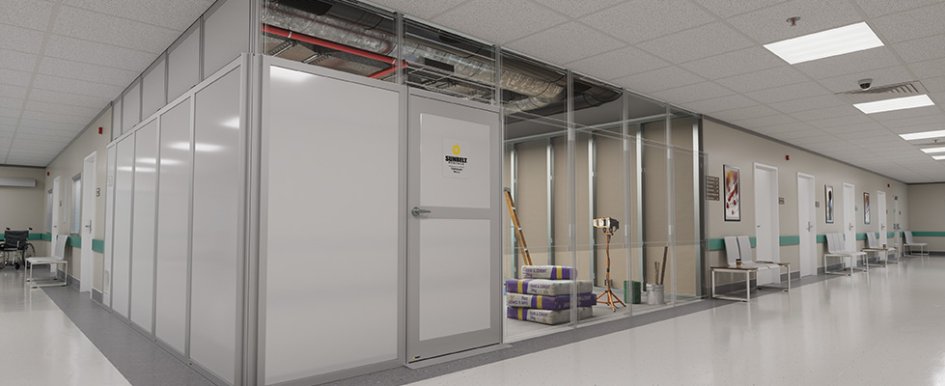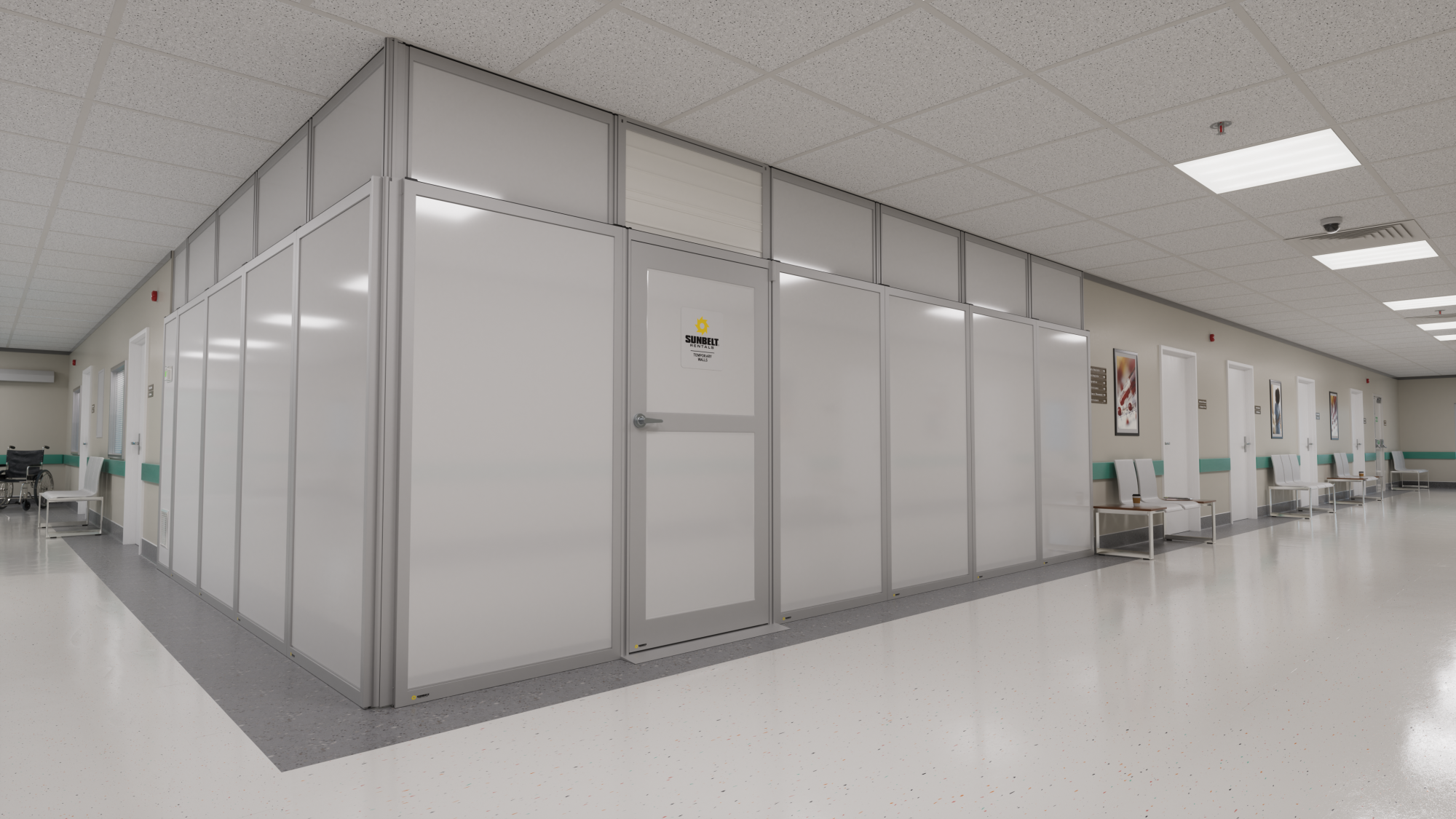
Have you ever entered a building being renovated and found the noise and dust off-putting? Or been inclined to find a different place to shop or to stay at a different hotel to avoid the activity of a construction job? If so, you aren’t alone. But there are ways that contractors can make renovation projects in public spaces quieter and safer — temporary containment walls.
While a relatively new option for indoor construction and renovation projects, temporary containment walls are growing in popularity. Since their introduction around 10 years ago, the systems are increasingly found in a range of facilities where it is necessary to protect the public from the work being completed by contractors and their teams. These include health care facilities, data centers, airports, retail spaces, hotels and more.
Temporary containment walls consist of an aluminum frame structure with a foam core, along with painted aluminum and galvanized steel panels. For aesthetic reasons, the aluminum panel side faces outward toward the public, while the galvanized steel faces toward the project to protect against damage from the construction activity. These walls are sturdy and reusable and keep dust and debris from escaping the area. They also reduce more noise than other containment methods.
Some rental providers stock temporary containment walls, offering these systems and their services as a turnkey solution to contractors. Rental providers erect the walls in occupied spaces with grid ceilings where there's a construction project underway. After the walls are in place, the rental provider will create negative air in that space by adding a HEPA filtration air scrubber and manometer. The manometer measures the pressure difference inside and outside of the walls, while the scrubber ensures that that air leaving the space is clean (HEPA filters provide approximately 99.96% clean air). This system is especially helpful in sensitive environments like hospitals and data centers.
The extra protection provided by the negative air is just one advantage of using temporary containment walls compared to other types of containment for indoor construction projects.

What Are the Traditional Methods & Pitfalls?
Typically, contractors rely on drywall to contain indoor construction projects. However, even with their popularity, there are several disadvantages to this method. It can be costly and time-consuming, since putting up these walls requires hiring separate vendors and multiple steps to complete. Drywall and the wood frame also create dust and debris in the process, which is the exact issue that contractors need to avoid.
For temporary construction applications, contractors will sometimes use plastic to block off an area. Unsurprisingly, this method does not offer much protection or security, which can pose a risk to the public.
Polycarbonate walls are another more secure method of containing indoor construction projects, but they are not reusable. That increases costs for replacement during future jobs.
What Are Additional Benefits of Temporary Containment Walls?
Along with keeping dust, debris and noise from the public, temporary containment walls offer many benefits for indoor construction projects, with rental adding to the advantages.
1. Safety & Compliance
Temporary containment walls are available that meet the ASTM E84 Class A Fire and Smoke Rating, which is the highest fire resistance level under the ASTM E84 test. The rating ensures that after 30 minutes of exposure to fire, the system will not exceed values set forth for flame spread index (FSI) or smoke developed index (SMI). Panels are also available to meet and exceed Infection Control Risk Assessment (ICRA) Class IV and V requirements. Meeting these requirements means that the space within the walls will contain any environment-associated infections. The addition of an air scrubber supports that compliance by creating negative air. Meeting both the E84 and ICRA requirements is necessary for construction projects in health care facilities.
2. Cost Savings
Like equipment rental, renting temporary containment walls is an operating expense, as opposed to a capital expenditure, and the responsibility of obtaining and caring for them is on the rental provider. This not only reduces a contractor’s barrier to investing in these systems, but it also eliminates the cost of storing the panels, transportation to and from the jobsite, and the labor to install, modify and remove the walls.
3. Fast Installation & Flexibility
Compared to drywall, temporary containment walls are quick to install, generally within hours. If modifications are necessary due to a change in the scope of the construction project, it is fast and easy for the rental provider to adjust the walls. Temporary containment wall panels also come in a variety of widths and heights, with the standard being 10 feet tall; taller panels are also available. The shape of the area is flexible, according to the project’s requirements, and additions, such as doors, extra panels or windows are all options to incorporate with little effort by the rental provider.
4. Less Waste
Because they are reusable, temporary containment walls eliminate the waste associated with using drywall or polycarbonate walls for indoor construction projects. For contracting companies that have sustainability goals, that advantage is attractive. Less waste also means less cost, since there is no need to hire vendors to tear down the walls or pay to rent dumpsters for material disposal.
5. Inventory Availability & Management
Some contractors have their own temporary containment walls for their construction projects; however, rental providers maintain an abundant inventory of the panels and accessories. This gives contractors greater availability and options, while also minimizing their inventory management. If a contractor needs doors, windows or extra panels, they can turn to rental to supplement their own inventory without the capital investment or having to secure additional storage for the panels.
How Else Can a Rental Provider Help?
Rental providers can offer guidance and education about temporary containment wall design, along with cost estimates. Having this assistance helps keep contractors’ projects on time and budget by providing the best recommendation up-front. In most cases, for longer-term rental (months as opposed to days), temporary containment walls are a cost-effective means to protect the public from construction activity within a facility. Having the rental provider take on the responsibility for inventory, delivery, setup, teardown and modification also frees up contractors to focus on the project at hand rather than the logistics of temporary containment walls.
